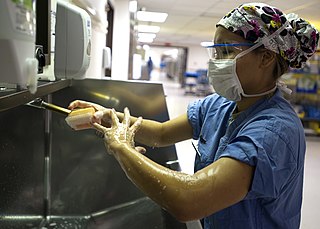Related Research Articles
Body substance isolation is a practice of isolating all body substances of individuals undergoing medical treatment, particularly emergency medical treatment of those who might be infected with illnesses such as HIV, or hepatitis so as to reduce as much as possible the chances of transmitting these illnesses. BSI is similar in nature to universal precautions, but goes further in isolating workers from pathogens, including substances now known to carry HIV.

Universal precautions refers to the practice, in medicine, of avoiding contact with patients' bodily fluids, by means of the wearing of nonporous articles such as medical gloves, goggles, and face shields. The infection control techniques were essentially good hygiene habits, such as hand washing and the use of gloves and other barriers, the correct handling of hypodermic needles, scalpels, and aseptic techniques. Following the AIDS outbreak in the 1980s, the US CDC formally introduced them in 1985–88. Every patient was treated as if infected, and therefore precautions were taken to minimize risk.

An infection is the invasion of tissues by pathogens, their multiplication, and the reaction of host tissues to the infectious agent and the toxins they produce. An infectious disease, also known as a transmissible disease or communicable disease, is an illness resulting from an infection.

Methicillin-resistant Staphylococcus aureus (MRSA) is a group of gram-positive bacteria that are genetically distinct from other strains of Staphylococcus aureus. MRSA is responsible for several difficult-to-treat infections in humans. It caused more than 100,000 deaths worldwide attributable to antimicrobial resistance in 2019.

A gait belt or transfer belt is a device put on a patient who has mobility issues, by a caregiver prior to that caregiver moving the patient. Patients may have problems with balance and a gait belt may be used to aid in the safe movement of a patient, from a standing position to a wheelchair, for example. The gait belt has been customarily made out of cotton webbing, with a durable metal buckle on one end. Cleanable vinyl gait belts were introduced due to the tendency of webbing to harbor supergerms.
In medicine, public health, and biology, transmission is the passing of a pathogen causing communicable disease from an infected host individual or group to a particular individual or group, regardless of whether the other individual was previously infected. The term strictly refers to the transmission of microorganisms directly from one individual to another by one or more of the following means:

A hospital-acquired infection, also known as a nosocomial infection, is an infection that is acquired in a hospital or other healthcare facility. To emphasize both hospital and nonhospital settings, it is sometimes instead called a healthcare-associated infection. Such an infection can be acquired in hospital, nursing home, rehabilitation facility, outpatient clinic, diagnostic laboratory or other clinical settings. A number of dynamic processes can bring contamination into operating rooms and other areas within nosocomial settings. Infection is spread to the susceptible patient in the clinical setting by various means. Healthcare staff also spread infection, in addition to contaminated equipment, bed linens, or air droplets. The infection can originate from the outside environment, another infected patient, staff that may be infected, or in some cases, the source of the infection cannot be determined. In some cases the microorganism originates from the patient's own skin microbiota, becoming opportunistic after surgery or other procedures that compromise the protective skin barrier. Though the patient may have contracted the infection from their own skin, the infection is still considered nosocomial since it develops in the health care setting. Nosocomial infection tends to lack evidence that it was present when the patient entered the healthcare setting, thus meaning it was acquired post-admission.

Viral hemorrhagic fevers (VHFs) are a diverse group of animal and human illnesses. VHFs may be caused by five distinct families of RNA viruses: the families Filoviridae, Flaviviridae, Rhabdoviridae, and several member families of the Bunyavirales order such as Arenaviridae, and Hantaviridae. All types of VHF are characterized by fever and bleeding disorders and all can progress to high fever, shock and death in many cases. Some of the VHF agents cause relatively mild illnesses, such as the Scandinavian nephropathia epidemica, while others, such as Ebola virus, can cause severe, life-threatening disease.

Asepsis is the state of being free from disease-causing micro-organisms. There are two categories of asepsis: medical and surgical. The modern day notion of asepsis is derived from the older antiseptic techniques, a shift initiated by different individuals in the 19th century who introduced practices such as the sterilizing of surgical tools and the wearing of surgical gloves during operations. The goal of asepsis is to eliminate infection, not to achieve sterility. Ideally, a surgical field is sterile, meaning it is free of all biological contaminants, not just those that can cause disease, putrefaction, or fermentation. Even in an aseptic state, a condition of sterile inflammation may develop. The term often refers to those practices used to promote or induce asepsis in an operative field of surgery or medicine to prevent infection.
Infection prevention and control is the discipline concerned with preventing healthcare-associated infections; a practical rather than academic sub-discipline of epidemiology. In Northern Europe, infection prevention and control is expanded from healthcare into a component in public health, known as "infection protection". It is an essential part of the infrastructure of health care. Infection control and hospital epidemiology are akin to public health practice, practiced within the confines of a particular health-care delivery system rather than directed at society as a whole.

Hospital-acquired pneumonia (HAP) or nosocomial pneumonia refers to any pneumonia contracted by a patient in a hospital at least 48–72 hours after being admitted. It is thus distinguished from community-acquired pneumonia. It is usually caused by a bacterial infection, rather than a virus.

In health care facilities, isolation represents one of several measures that can be taken to implement in infection control: the prevention of communicable diseases from being transmitted from a patient to other patients, health care workers, and visitors, or from outsiders to a particular patient. Various forms of isolation exist, in some of which contact procedures are modified, and others in which the patient is kept away from all other people. In a system devised, and periodically revised, by the U.S. Centers for Disease Control and Prevention (CDC), various levels of patient isolation comprise application of one or more formally described "precaution".

Ceftaroline fosamil (INN), brand name Teflaro in the US and Zinforo in Europe, is a cephalosporin antibiotic with anti-MRSA activity. Ceftaroline fosamil is a prodrug of ceftaroline. It is active against methicillin-resistant Staphylococcus aureus (MRSA) and other Gram-positive bacteria. It retains some activity of later-generation cephalosporins having broad-spectrum activity against Gram-negative bacteria, but its effectiveness is relatively much weaker. It is currently being investigated for community-acquired pneumonia and complicated skin and skin structure infection.

In hospitals and other medical facilities, an isolation ward is a separate ward used to isolate patients with infectious diseases. Several wards for individual patients are usually placed together in an isolation unit.
Transmission-based precautions are infection-control precautions in health care, in addition to the so-called "standard precautions". They are the latest routine infection prevention and control practices applied for patients who are known or suspected to be infected or colonized with infectious agents, including certain epidemiologically important pathogens, which require additional control measures to effectively prevent transmission. Universal precautions are also important to address as far as transmission-based precautions. Universal precautions is the practice of treating all bodily fluids as if it is infected with HIV, HBV, or other blood borne pathogens.
Carbapenem-resistant Enterobacteriaceae (CRE) or carbapenemase-producing Enterobacteriaceae (CPE) are Gram-negative bacteria that are resistant to the carbapenem class of antibiotics, considered the drugs of last resort for such infections. They are resistant because they produce an enzyme called a carbapenemase that disables the drug molecule. The resistance can vary from moderate to severe. Enterobacteriaceae are common commensals and infectious agents. Experts fear CRE as the new "superbug". The bacteria can kill up to half of patients who get bloodstream infections. Tom Frieden, former head of the Centers for Disease Control and Prevention has referred to CRE as "nightmare bacteria". Examples of enzymes found in certain types of CRE are KPC and NDM. KPC and NDM are enzymes that break down carbapenems and make them ineffective. Both of these enzymes, as well as the enzyme VIM have also been reported in Pseudomonas.
An admission, discharge, and transfer (ADT) system is a backbone system for the structure of other types of business systems. An ADT system is one of four types of core business systems: ADT, financial, scheduling, and acuity. Core business systems are systems used in a health care facility for financial payment, quality improvement, and encouraging best practices that research has proven beneficial.

Prevention of viral hemorrhagic fever is similar for the different viruses. There are a number of different viral hemorrhagic fevers including Ebola virus disease, Lassa fever, Rift valley fever, Marburg virus disease, Crimean-Congo haemorrhagic fever (CCHF) and yellow fever. Lassa, Ebola, Marburg and CCHF can be spread by direct contact with the body fluids of those infected. Thus the content here covers the prevention of Ebola.

Dale Andrew Fisher FRACP is an Australian physician who specialises in Infectious Diseases and is a Senior Consultant in the Division of Infectious Diseases at the National University Hospital, Singapore. He is also a professor of medicine at the Yong Loo Lin School of Medicine, National University of Singapore, the chair of the National Infection Prevention and Control Committee through the Ministry of Health, Singapore, and chair of the steering committee of the Global Outbreak Alert and Response Network hosted by the World Health Organization.
An occupational infectious disease is an infectious disease that is contracted at the workplace. Biological hazards (biohazards) include infectious microorganisms such as viruses, bacteria and toxins produced by those organisms such as anthrax.
References
- 1 2 "Barrier Nursing". BMJ. 1 (5492): 876. 1966. doi:10.1136/bmj.1.5492.876. ISSN 0959-8138.
- ↑ Gammon, J. (March 26 – April 8, 1998). "A review of the development of isolation precautions". British Journal of Nursing. 7 (6): 307–310. doi:10.12968/bjon.1998.7.6.5727. ISSN 0966-0461. PMID 9661353.
- 1 2 Landers, Timothy; McWalters, Jessica; Behta, Maryam; Bufe, Gina; Ross, Barbara; Vawdrey, David K.; Larson, Elaine (October 2010). "Terms used for isolation practices by nurses at an academic medical center". Journal of Advanced Nursing. 66 (10): 2309–2319. doi:10.1111/j.1365-2648.2010.05398.x. ISSN 0309-2402. PMC 2974777 . PMID 20722801.
- ↑ Riley, Unell (2009). Treleaven, Jennifer; Barrett, A John (eds.). Hematopoietic Stem Cell Transplantation in Clinical Practice. Edinburgh: Churchill Livingstone. pp. 355–361. ISBN 9780443101472.
- 1 2 Enría, Delia A.; Mills, James N.; Bausch, Dan; Shieh, Wun-Ju; Peters, C. J. (2011). Guerrant, Richard L.; Walker, David H.; Weller, Peter F. (eds.). Tropical Infectious Diseases: Principles, Pathogens and Practice (Third Edition). Edinburgh: W.B. Saunders. pp. 449–461. doi:10.1016/B978-0-7020-3935-5.00068-9. ISBN 9780702039355.
- 1 2 Mahmoud, H. K.; Schaefer, U. W.; Schüning, F.; Schmidt, C. G.; Bamberg, M.; Haralambie, E.; Linzenmeier, G.; Hantschke, D.; Grosse-Wilde, H. (1984-11-01). "Laminar air flow versus barrier nursing in marrow transplant recipients". Blut. 49 (5): 375–381. doi:10.1007/BF00319885. ISSN 0006-5242.
- ↑ Formenty, Pierre (2014). "Ebola Virus Disease". Emerging Infectious Diseases. Amsterdam: Academic Press. pp. 121–134. doi:10.1016/B978-0-12-416975-3.00009-1. ISBN 9780124169753.
- ↑ Warrell, Mary J. (2014). Farrar, Jeremy; Hotez, Peter J.; Junghanss, Thomas; Kang, Gagandeep; Lalloo, David; White, Nicholas J. (eds.). Manson's Tropical Infectious Diseases (Twenty-Third Edition). London: W.B. Saunders. pp. 195–206.e2. doi:10.1016/B978-0-7020-5101-2.00018-2. ISBN 9780702051012.
- 1 2 3 4 5 6 7 8 9 Barratt R, Shaban R, Moyle W (2010). "Behind barriers: patients' perceptions of source isolation for Methicillin‑resistant Staphylococcus aureus (MRSA)". Australian Journal of Advanced Nursing. 28 (2). hdl: 10072/35631 .
- ↑ "PRIME PubMed | 'Patient perspective'--psychological effects of barrier nursing isolatio". www.unboundmedicine.com. Retrieved 2017-12-14.